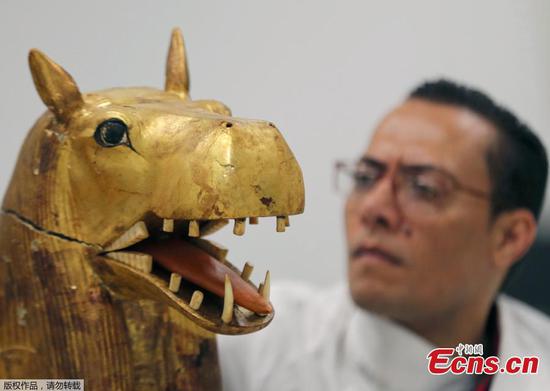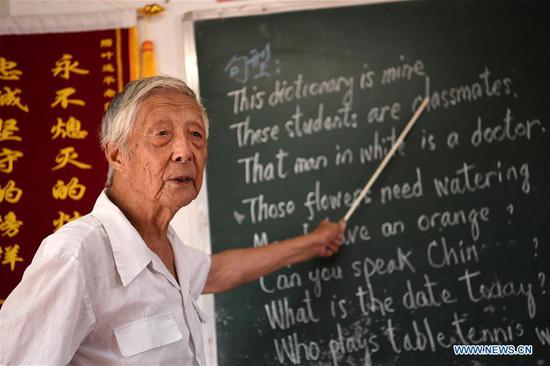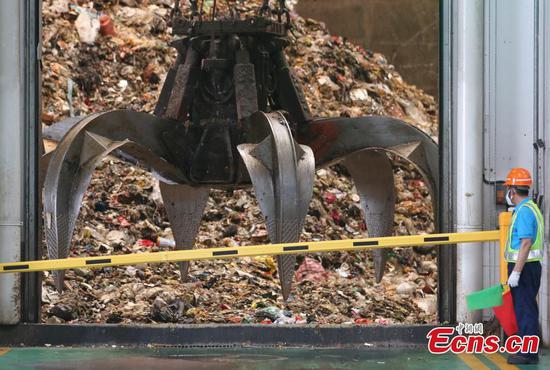Chinese yuan breaks 7 mark, shows country ready to retaliate U.S. tariff threat: analysts
The yuan weakened past 7 to the U.S. dollar for the first time in more than a decade, in a move that signifies the Chinese government's rising intention to pursue retaliation against the U.S.
On Monday morning, both onshore and offshore yuan weakened past 7 versus the U.S. dollar, a key psychological level the Chinese currency hasn't breached since 2008.
The yuan will be kept basically stable at a reasonable and equilibrium level, the People's Bank of China (PBOC), the country's central bank, said Monday, defusing concerns over the yuan's slide past a key mark.
The yuan's sudden weakness, according to PBOC, was due to to multiple factors including unilateralism, trade protectionist measures and expectations for the U.S. imposition of tariffs on Chinese products.
In a fresh sign of trade-war escalation, U.S. President Donald Trump on Thursday tweeted a threat to impose additional 10 percent tariffs on all remaining $300 billion worth of Chinese imports.
The PBOC's remarks were echoed by market watchers, who describe the weakening of the yuan as normal market reactions to Trump's threat of new China tariffs as well as the dollar's strength.
The market anticipated the negative impact of the tariff increase on China's trade in the future, and the yuan depreciated as a result to offset such influence, Zhou Yu, director of international finance under the Shanghai Academy of Social Sciences, told the Global Times Monday.
As the tariffs threat came a bit suddenly, the market reaction was also a little strong, Zhou said.
Ding Jianping, a professor at the Shanghai University of Finance and Economics, told the Global Times, said that the rising U.S. Dollar Index recently, resulting partly from the Fed's interest rate cut, has exerted pressure on the yuan to depreciate.
"The yuan's depreciation does not represent any abnormal fluctuations of the domestic economy," Ding remarked.
As Zhou put it, the yuan's depreciation would give a boost to China's exports. The nation's yuan-denominated foreign trade rose by 3.9 percent year-on-year in the first half, with exports up 6.1 percent and imports up 1.4 percent, per Chinese customs data.
"With the yuan breaching the 7 mark, the market's psychological tolerance of the currency will be gradually ratcheted," Wu Jinduo, head of fixed income at the research institute of Great Wall Securities, told the Global Times Monday.
That suggests the weakening of the yuan will help reduce risks associated with the exchange rate's low fluctuations in the long term, the downward pressure on the economy and asset bubbles, although it would deal a blow to market sentiment in the short run, according to Wu, also a part-time fellow of the Development Research Institute at Fudan University.
The continuation of trade frictions has led to a marked increase in market uncertainty, and depreciation pressure on the yuan also puts yuan-denominated assets under pressure, Hong Hao, managing director and head of research at BOCOM International, told the Global Times on Monday.
The yuan's depreciation pressure also indicates the market's expectations for policy easing, he said.
The PBOC also assured the markets of yuan stability. In its remarks on Monday, the central bank said that the yuan will maintain stability and strength against a basket of currencies.
The 7 mark that the yuan has breached against the dollar is not a number describing its age, nor is it acting like a dam blocking floods. The number seems more like water level marks in a reservoir, which elevate during high flow periods but lower during droughts, meaning both the rise and fall are the norm, the central bank explained in a vivid description.
The 7 mark that the yuan has breached against the dollar is not an Arabic number describing its age, nor is it acting like a dam blocking floods. The number seems more like water level marks in a reservoir, which elevate during high flow periods but lower during droughts, meaning both the rise and fall are the norm, the central bank explained in a vivid description.
Analysts also agreed upon yuan stability in the long term.
Ding predicts that the yuan will continue to operate stably in the long term and is likely to rebound in the next few months.
Expressing concerns that the yuan may depreciate further if trade frictions worsen, Zhou believes the government would intervene if a worse-case scenario were to occur.
"But if the yuan slips to around 10 against the greenback, the government might take some measures to prop the yuan."
Also worth noting is that yuan weakness actually serves to offset the impact of the trade war on China.
The flexibility and moderate weakening of the yuan helps in stabilizing growth and ensuring job additions, partly offsetting the shockwaves trade tariffs have sent through the business sector, according to Wu.
In Zhou's words, the yuan's depreciation level can cancel out influence from the same level of tariff increases.
The yuan has weakened by about 1 percent so far this year in terms of daily fixing rate. The yuan's daily fixing was weakened by 229 points to 6.9225 on Monday.
Both Chinese mainland shares and H shares fell during the morning session on Monday. The benchmark Shanghai Composite Index shed 0.81 percent to 2,844.47 points by market close in the morning session, while the Hang Seng Index sank 2.89 percent to 26,140.72 points. U.S. stock futures also plunged, implying U.S. stocks are set to tumble at market opening Monday.


















































